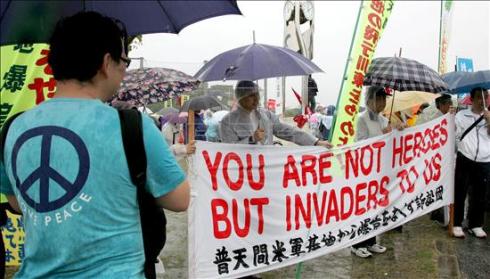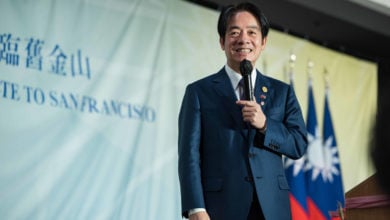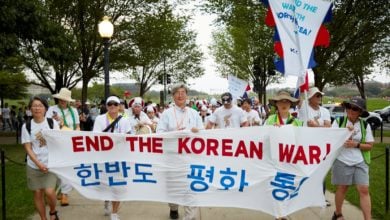This article is based on a talk given at a Party for Socialism and Liberation forum.
Over the past month, there has been a small news storm poking at the Chinese government for “cracking down” on a so-called “pro-democracy” movement in Hong Kong. American news stories ran more or less the same way. Hong Kong was turned over to China as one of the British Empire’s last colonial possessions in 1997. The transfer laid out specific conditions in Hong Kong that led only to partial incorporation into the PRC, keeping its common law system, its own currency and the western-style political system established by Britain over 150 years before.
In other words, Hong Kong was never really integrated back into China’s control—it still retains the structure of its old colonial government with many of the same old ruling elites and the same old economic relationships. The recent news is a result of the conflict—the contradiction —between the Hong Kong government and the central government in Beijing and the two
systems they protect.
This is to say that even today, the news in China is news of imperialist conflict, where the Chinese government is in a struggle to defend its system against the western-style Hong Kong system. Just like the preservation of Hamas’ sovereign political authority as the elected leadership of Gaza is fundamentally opposed to Zionist militarism, the preservation of the Communist Party of China—despite its embrace so-called “market socialism”— is completely at odds with colonial hangers on who preserved the old colonial government as it formally left the British Empire.
That there is an imperialist conflict over Hong Kong between China and the global imperialist powers speaks to a larger context of imperialist conflict in Asia. The clearest indicator that there is significant imperialist meddling in Asia is imperialist countries’ physical presence there: the colonial garrisons in South Korea, Indonesia, Philippines, etc. together number in the tens of thousands. Each was established after a war the United States entered into in an imperialist capacity.
The first garrison, in the Philippines, traces its origins back to the Spanish-American War, where the United States scrambled after the crumbling Spanish Empire’s colonies amid national liberation struggles against the old imperialists. Just as European countries like France, Germany and Britain were building huge overseas empires to keep profits high by keeping labor and resource costs low, the United States turned abroad at the turn of the 20th century for new markets.
The garrison in the Philippines was never withdrawn since the Spanish-American War, except for a brief hiatus when the Japanese Empire forced them to retreat in another land-grab between imperialists during World War Two.
The same goes for the 30,000-strong presence in South Korea, which took the place of the old Japanese colonial garrisons in the last days of World War Two, as the United States requested that the Japanese Army hold out as long as possible against the invading Soviet Red Army, which had just joined the Allies in the war against the Japanese Empire.
The United States’ sudden change of heart towards the Japanese Imperial army was not a peculiar accident of history; it was the beginning of a new chapter in history, the beginning of the Cold War. The period of competition and rivalry between the imperialist powers—between the Britain
and Germany, between the United States and Japan—was gone. The old imperialist powers of Europe—Germany, France, Britain, Belgium—were in ruins by the end of World War Two.
In their wake, the Soviet Union emerged as the primary competitor to the United States, which had come out of the Great Depression with basically no serious economic wartime losses; while 27 million Soviets lost their lives during the war—of whom 15 million were civilians—the United States was geographically shielded from the brunt of the fighting. This also spared the United States from the destruction which economically devastated most of Europe and Asia.
The two systems that the United States and Soviet Union represented were violently opposed, and the business and political establishment in the United States and other imperialist countries knew that. In fact, Winston Churchill even drew up plans to invade the Soviet Union in 1945-1946, immediately after the end of World War Two.
The reason this matters today is it set the stage for the present world situation. Imperialism, just like the in era of World War One and World War Two, is the dominant world condition. The difference is that there are no longer two, three, many imperialist countries competing with each other on similar ground, but one that is completely dominant from a military and economic point of view—the United States. All the imperialist world was therefore more or less consolidated in opposition to socialism, notably unified under NATO. Other countries—such as Germany, France, South Korea and Japan—are not competitors to US imperialism as other powerful capitalist countries like they were before they were devastated by World War Two, but junior partners of US imperialism.
That is why the Germany, France and other NATO countries generally are on the same side as the US in major foreign policy disputes, alongside the United States’ East Asian junior partners like South Korea and Japan.
They had to be united to counter their shared rivals: the Soviet Union and the people’s movements bubbling up in East Asia, South America, Africa and elsewhere, which were the common enemy of big business. People around the world were not willing by the end of World War Two to simply trade colonizers. Particularly in East Asia, mass people’s movements in Vietnam, Korea and China rose up to oppose Japanese invaders, which sought to kick out the old European empires and make most of Asia its colonial dominion. These movements became expert, fighting movements over the course of their resistance, and had become the de facto leaders of their respective countries.
More concerning to the old imperial powers, who looked back to Asia longing to re-inherit their old empires, communists were at the head of these movements.
In other words, the world had become divided into two blocs: one the one hand, there were the pro-people’s movements in the Soviet Union and in the national liberation struggles in East Asia; and then there was the newly-united imperialist bloc on the other.
This was such an issue that it was a major political stumbling block for the Democratic Party for over a decade when Democratic President Harry Truman “lost China” to a communist revolution in 1949.
Fifty years later, the Soviet Union was in the process of getting dissolved, and China had opened its doors to capitalist investment. Imperialism appeared to have won. The Soviet Union no long could militarily stand in the way for endless imperialist expansion, and China looked like it had come to terms with imperialism.
Nevertheless, the Chinese Communist Party was still the ruling party of the People’s Republic, and opportunities for foreign investment were and are tightly controlled. To invest in a factory in China, companies have to share their technology, meet certain Chinese regulations and have limited access to the Chinese labor market on terms set by the government.
This is not a deal that totally opens the door to capitalism in China. It is only able to do this because of the remaining vestiges of socialism in China. The state is still able to decisively set the terms for foreign trade. Significant parts of the economy—particularly in terms of heavy industry like steel production—are still publicly owned.
In other words, China is in some key ways still a socialist country. The Chinese Workers’ State has yet to be overthrown in full, though it is under attack from without and from within by domestic capitalists, who, like their foreign counterparts, want anything and everything to be for sale on their terms. They want a total restoration of capitalism in China.
It doesn’t take a particularly careful observer to see China is constantly vilified in the news. From the racist campaign against China during the 2008 Olympics, to the massive media campaign around the 25th anniversary of Tiananmen Square to the new Red Dawn (which originally had China as the invading army), it is easy to see that China is next to the bogeyman to politicians and corporate media.
This is the context for Obama’s so-called “Asia Pivot,” or the strategic focus on East Asia. In an article in Foreign Policy Magazine, not so subtly entitled “Surrounded: How the U.S. Is Encircling China with Military Bases,” there is a pretty detailed description of what exactly the Pivot means military: expanding military bases, refurbishing old ones inherited from Japan after World War Two or in join possession with imperialist junior partners, re-balancing troop deployments to be centered in East Asia, etc.
Where the War on Terror was the general strategic framework for the Bush Administration, the new orientation is the Asia Pivot. Before, oil security and toppling the strong and independent regional powers that could affect oil supplies were the U.S.’s primary concerns. Now China and North Korea are in the crosshairs as two of the most serious opponents of US imperialism in East Asia.
Also in an article in Foreign Policy Magazine, Hillary Clinton, when she was Secretary of State, defined the Asia Pivot by 6 policy goals:
1. strengthening bilateral security alliances
2. deepening America’s relationships with rising powers, including China
3. engaging with regional multilateral institutions
4. expanding trade and investment
5. forging a broad-based military presence
6. advancing democracy and human rights
Clinton’s article not so subtly made it clear that the Asia Pivot is aimed specifically at China and North Korea, especially given the constant screed about “democracy and human rights” in China and North Korea, which was the cover to start war against Iraq, and is the language used by the apologists of Zionism. Tensions over South China Sea over the Diaoyu Islands (Japanese and U.S. media alike call the Senkakus) is another clear example framing the Pivot, where Japan—whose bilateral alliance with the United States is literally written into its constitution in Article 9—is constantly threatening China over oil reserves near the Islands, and where real military tensions have flared up over the past five or so years.
In essence, the six points can be read as this: the United States wants to strengthen its bilateral alliances with South Korea and Japan—the two closest bilateral partners of the US in the region—so that it can “deepen America’s relationships” with rising powers (China) on its own terms. That means engaging in multilateral institutions like ASEAN with its bilateral allies to encircle China beyond a simple military encirclement. This will help with trade and investment, since the U.S. will have a better bargaining chip with China and closer relationships with junior imperialist partners help with smoothing over any differences. This approach will be backed up by “forging a broad-based military presence,” that is by building up more troops in Asia, which will be send in the name of “democracy and human rights.”
Imperialism brought U.S. to Asia, so imperialism is the mainline for U.S. policy in Asia, since the objectives named in developing U.S. presence are so obviously imperialist. They are based on generally projecting military power in Asia, right as China becomes a serious economic power.
China makes up half the world’s population, but is independent—often opposed—to imperialism; look no farther than China’s trading with Cuba, which is done at bottom-rate prices. Since the U.S. can’t afford to punish China for breaching its blockade, it has no choice but to ignore China’s support for socialist Cuba. This and other conditions and policies of China—notably its massive investment into green energy—show China not as anew rival imperialist power, but a force independent of imperialism.
Political independence is particularly threatening to imperialism. The politics of imperialism is a fighting arm in the interests of the economics of imperialism; the politics of anti-imperialism serve the economics of anti-imperialism.
In other words, the Asia Pivot is the foreign policy of present-day imperialism, which demands anything and everything for the United States. China and North Korea are serious impediments to that demand. Since modern capitalism is imperialism—since it requires cheap labor and natural resources sourced abroad for ample profit—anti-imperialism is anti-capitalism for people living in the United States and other imperialist countries. Opposing imperialism means we oppose the acquiring of cheap market opportunities at gunpoint, which is the sole condition of capitalism’s survival at the present.
It is our duty, as people opposed to oppression and exploitation in the heart of global imperialism, to be anti-capitalist, which is to be anti-imperialist.
This is the real danger of state-department socialism, or defining socialism as an idealized list of 57 characteristics. State-department socialists were on the wrong side of the Iraq war because “Saddam Hussein was too terrible to defend.” They called for “sanctions not war,” even though sanctions were the prelude to war. State department socialism is also opposed to defending China as against imperialism and counter-revolution, instead calling it “just another capitalist country,” despite China’s international record and economic policy.
It is for this reason—anti-imperialism is anti-capitalism is anti-imperialism—that all progressive people should link the struggles for national liberation from Gaza to Guangzhou to the Gambia to Guatemala. If we are opposed to exploitation, we are opposed to capitalism. If we are opposed to capitalism, we are opposed to imperialism. If we are opposed to imperialism, then we are supposed to fight in word as well as in deed. To fight, we need to make an enemy of confusion and deceit in the media and from high-sounding anti-Chinese and anti-Korean grandstanding.
We need to know that these countries—as countries still upholding fundamentally pro-people missions and meaningfully opposing imperialism—merit our support against exploitation. It is our duty as people in the United States opposed to U.S. imperialism, opposed to oppression, opposed to capitalism, to uphold those countries as opposing a common enemy.







